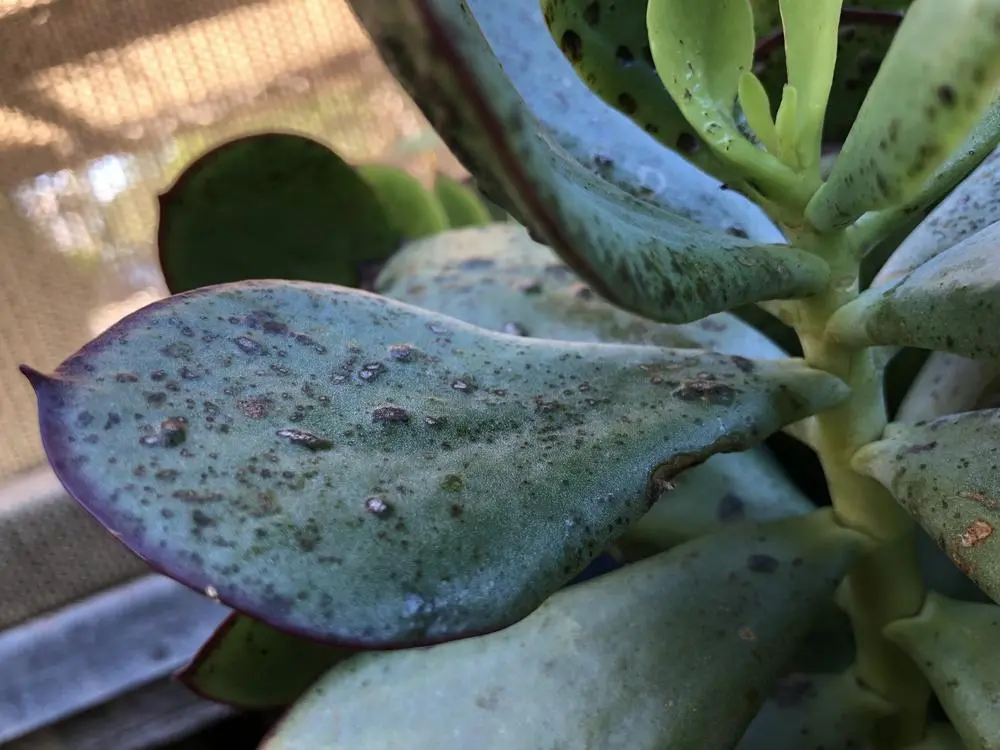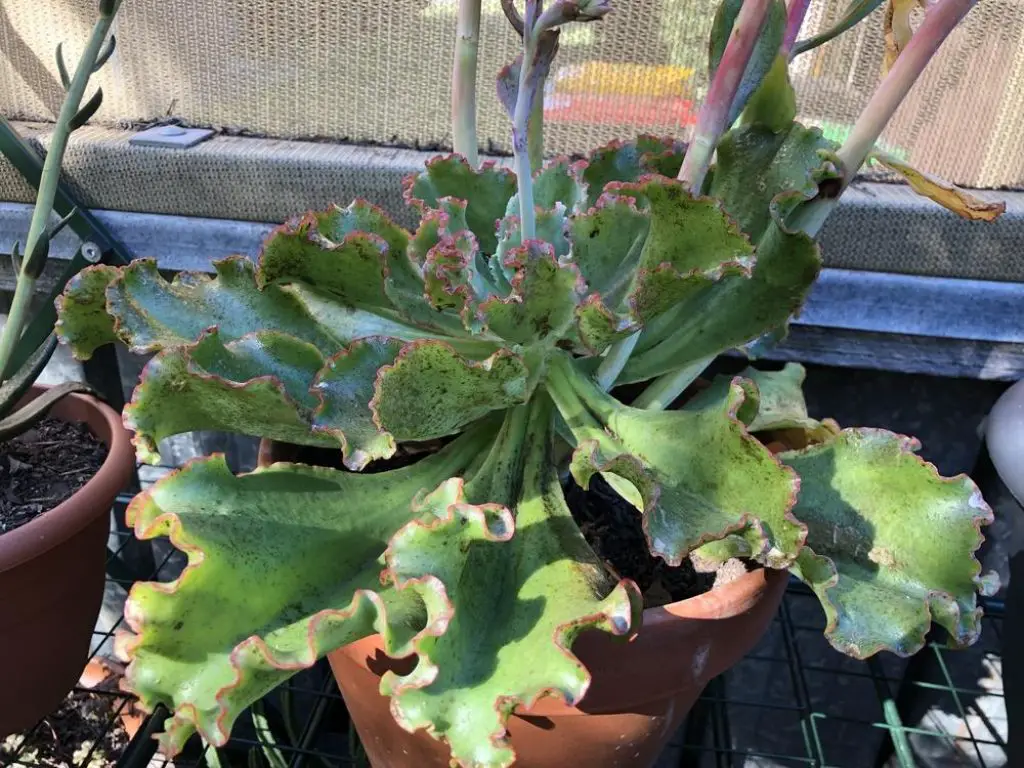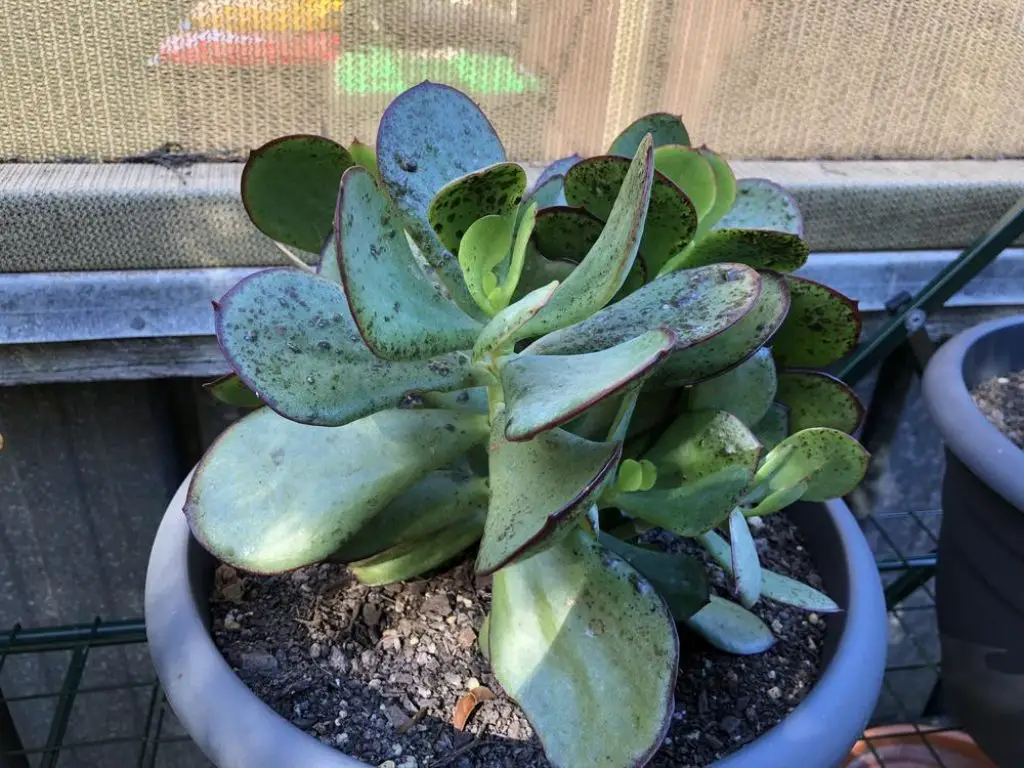Black Spots on Succulents- 7 Causes With Cures

Succulents are popular among home growers for being easy to maintain. But if you fail to maintain succulents properly, they will be vulnerable to diseases and pests.
Chances are you’re facing difficulties with your succulents or as a novice gardener, you want to know things from the very beginning.
Whatever the thing is, do not worry about the black spots on succulents.
Because this article will go over the causes with remedies of tiny black spots on succulent leaves. So, let’s see what is stored for you!
7 Causes of Black Spots on Succulents
The appearance may look in the same way but there are several reasons for black spots on your succulents. For your kind perusal, we have compiled 7 causes and symptoms of happening so with cures.
Cause 1: Over-watering
Succulents can save water in various parts of them. For this, they can survive even without water for a long time. So, there’s no chance to overwater them.
If you overwater succulents, chances are their tissues will be overfilled with water. And, it can lead the succulent to be vulnerable to various fungal diseases.
Symptom: So, how can you make sure that your succulents are facing overwatering? Look closely at the black spots on the plant. If, the spots seem mushy and soft, then you’ve been overwatering the plant.
Cure: After being sure that you’re overwatering the plants, the first thing you need to do is to set aside the affected plants from the pots and look carefully at the roots.
If you find the roots still healthy, then repot the plant in a new pot that has draining holes. But before you do this, remove the damaged leaves plus black spot on succulent stem.
Using a new pot with a drainage hole as well as a fast-draining soil mix will help to cure.
After that, try to maintain the right watering routine. Do not let your succulents sit in damp or wet soil for a long time (more than 2-3 days).
And, the best watering frequency for succulents is when the leaves indicate VERY EARLY signs of underwatering.
Avoid watering using a spray bottle. If you constantly water the succulents even if with a small amount of water, this can lead the weak system to become weaker.
To sum up, try to soak & dry your succulent.

Cause 2: Sunburn
Yes, it’s true that succulents like sunlight. But not when the temperature exceeds 100 degrees Fahrenheit. The ideal temperature range for succulents is 60-80 degrees Fahrenheit.
Many of the succulents can tolerate as high a temperature as 90 degrees Fahrenheit or as low as 80 degrees Fahrenheit. But most of the plants get damaged if the temperature is more than 100 degrees Fahrenheit.
Symptom: Different plants show different symptoms if they are exposed to scorching sun rays. For example, succulents can face leaves falling off, damaging the root system.
However, most of the plants get black spots on them. But how can you be sure that you are not overwatering, these black spots are because of sunburn?
Look closely at the black spots, if they are dry instead of being mushy or soft, then it is happening because of sunburn.
Cure: The first move should be removing the damaged part. A bit harder but crucial action you should undertake is acclimating your succulent to a new location.
If you are going to move an indoor succulent to outdoor, firstly, put the plant under the morning sun at least for 3-4 hours. And then, bring the succulent indoors or just in a shaded area.
Try to enhance the succulent’s exposure to the morning sun spending 1-2 hours daily. Your succulent will be ready for a new life outdoors when it is around the fourth day.
Cause 3: Pest Infestations
Pest infestation is another reason for the black spots on the succulents. The attack can start from tiny, little aphids to big caterpillars, slugs, snails, and grasshoppers.
Yes, even bigger animals like mice, kangaroos, birds, or deer can attack succulents and feed on them. The bigger animals may take big chunks whereas the tiny pests and insects will leave tiny marks on the foliage. And, guess what?
The tiny marks on the foliage will turn into a dark color that will end up black spots. And, that’s not the end. The bitterest part is, these black spots will be there permanently until the succulents growing out of it.
Some Common bugs which cause trouble for Succulents:
Mealybugs
Small insects that usually grow from 2 to 3mm long, having a unique characteristic (producing a white-colored waxy substance) are called mealybugs.
Mealybugs act the best to hide. You’ll find them in the narrowest and totally unexpected places like in the underside of the plant’s joints, roots, or leaves. Also, they can hide in the debris around your plant.
Mealybugs can lay between 300-600 eggs even keeping it out of sight. However, they lay near the plants. Because it will help the little nymphs to crawl a little distance while they hatch.
Cure: Controlling mealybugs is a hard nut to crack as they contain a cover that defends them from insecticides or pesticides. For this, early detection plus isolation is the best option.
Nevertheless, if you see one or two bugs, immediately squash them using a toothpick. After that, remove the affected leaves and check thoroughly the plant whether there’s a single bug left.
But if your succulent is in an advanced stage that there’s a huge amount of mealybugs, you need to take an advance action. At this moment, spraying 70% of rubbing alcohol or isopropyl solution will work great.
Once the treatment goes well, you need to keep the succulents neat and clean from mealybugs or anything unwanted.
Aphids
Aphids are also known as greenflies or plant lice and they usually feed on the flowers or leaves of the plants. Moreover, they repopulate so fast that if you delay taking actionable steps, they can be huge in number.
Aphids are used to secrete a substance called honeydew that can attract ants and lead to developing molds.
Cure: You can notice aphids easily seeing their brown, green, black, or even orange color. If they are not so many in number, you can squash them using a toothpick and then wash off.
But if there are too many to do the job, you can apply pyrethrum based sprays to kill them, it’s quite easy.
You may need to deal with the larger infestations using pesticides. But there’s a problem. Pesticides are so effective that they can kill a good amount of beneficial insects too which should not be your intention.
Okay wait, there are ways. You can apply the pesticides at night as the beneficial insects will not be flying at night. This can help the aphids go away day by day.
What else you can do is to isolate the infected plants (in a shade) and apply neem oil spray on them. But it won’t work that efficiently since many of the aphids can survive it easily.
Scale
Two of the thousands of species of scale, the soft scale and the armored scale are most commonly attack succulents. What these do is to damage the plant and leave it vulnerable to various diseases.
You’ll find brown or black spots on succulents if there’s any scale infestation.
Cure: If the infestation is at the very beginning stage, you can simply remove them manually. But if the infestation seems severe, treat your succulent just like the treatment of mealybug infestation.
Apply diluted alcohol through a spray bottle or soak cotton into alcohol then wipe the cotton on the insects. Remember to check the roots of the succulent whether the scales are there or not.
If they are on the roots, clean the plant including the roots, and use the alcohol spray. Now, wait for a moment when it dries. After that, re-pot your succulent with fresh soil.
Cause 4: Fungus, Water Warts, and Rot
In warm and humid areas of the world, fungus infections, water warts, and rot in succulents are common. It not only happens when you overwater a succulents but also when there is lots of moisture in the air.
Fungus will create brown or black spots (round-shaped) on succulent. Over the time, these black spots will colonize the entire leaf that may tend to fall off.
Sometimes, you can count the black spots like one or two per plant and sometimes there are too many to count.
If you are in a humid area, it’s better to limit watering frequency otherwise, it will stress the succulent and cause the leaves wilting.
And a piece of bad news is if you notice your succulent is rotting and the leaves, stems, and roots are going black, mushy then there is nothing much to do.
Cure: Spray a fungicide at night or evening as the fungicide doesn’t kill the beneficial insects of your plant. And, when it is a high humidity season, apply the fungicide every other week.
When very hot, water your succulent once a week. Water carefully to the root areas instead of spraying on the foliage.
About rot, if the rot isn’t at the top of your plant yet and the leaves are disinfected, you can cut the rotting part off and plant the succulent as a cutting.
Cause 5: Frost
Frost can affect your succulents in a similar way of sunburn. But it’s not your headache if you do not live in such an area where temperatures dip below 32 degrees Fahrenheit.
The symptoms of frost are quite similar to the symptoms of sunburn. In the beginning, simply dark spots will appear on the foliage. Over time, when the frost will become severe, the plants may collapse.
Cure: To protect the succulent from frost, you can use a frost cloth over the plants. But there are plants like Sempervivums that are so vulnerable to frost that using a frost cloth will not protect this.
So, you live in an area with excessive cold winters where snow settles for days or months, then keep your succulents indoors until the risk of frost goes away.
Cause 6: Viral Diseases
Viral diseases like ‘the black ring’ can be responsible for the black spots on your succulents. The viral disease can spread through any insect infestation or the use of any infected grafting knife.
The most common effects of viral diseases for succulents are black spots, overgrown shoots, or stunted growth.
Cure: The bad news is if once your succulent gets infected with a viral disease, there is nothing left to discard it. For this, prevention is a crucial point here. Prevent any insect infestation from the beginning. Also, use a disinfected grafting knife while handling your succulents.
Cause 7: Trauma
Succulents that come up with a bluish or whitish wax coating named farina are more susceptible to scratch or puncture marks.
As the tiny, little pests feed on succulent leaves and scratch the surface of those leaves, it can finally cause getting black spots. The same can happen if anything falls on your succulent during repotting or something like that.
However, if the cause is this, you can understand and differentiate it from other reasons just seeing the scratches.
Cure: When it already happened, there’s nothing to do, sorry. You have to wait until the succulent grows out of that damaged area. To prevent such a thing, handle your succulents more carefully and avoid rubbing the leaves.
5 Pro Tips To Prevent Black Spots on Succulents
Before we end today’s discussion, here’s a bonus point for you. Have a look over the 5 ways to prevent getting black spots on your succulents.

Maintain Good Hygiene
The key to preventing pests or diseases from your plants is maintaining good hygiene of your garden. When the succulents will pick up dust on the plant surface, it will stunt their growth.
So, keep the plant clean and remove any dead flowers or leaves from the ground. The higher level of maintenance would be using a disinfectant that will keep the disease and pests away. 70% of isopropyl alcohol will work great as a disinfectant.
Choose a Pot with Drainage
As we told before, overwatering can do a lot of harm to your succulents. Therefore, plant them in a container with a drainage hole that will help the excess water to escape.
And, eventually, it will prevent root rot. As a beginner, you can use terra-cotta pots to plant succulents.
Keep the Plants on Inspection
If you give a little time to your plants regularly, it will be a huge help to prevent them from any pest and disease. When you water the plants, give it an extra two minutes and check the conditions of the plant.
Since pests and diseases can spread very quickly, you need to take actionable steps just at the moment of observing any unusual thing.
Also, keep an eye on the growth of your plant. Poor growth of your plants indicates unusual things. It may be because of overwatering, pests, or fungal infection. So, try to listen to your plants when they try to say something.
Ensure Proper Watering
In the growing seasons, succulents will naturally need more energy. So, you need to water them according to their demand in each season. For example, plants drink more water during summer and spring than winter and fall.
Better if you test the soil with a finger, see if the top (1.25 inches) of the plants are dry, go and water the plants. Avoid overwatering and let the soil be dried between waterings.
Moreover, water directly to the soil. Avoid using a spray bottle for watering, that can cause black mold on succulent leaves or brittle roots.
Be Careful of Bugs
Keeping the plants clean will help the bugs keep away. Yet, seal a single chance of happening this to your plants. Mainly, plants that are planted in such soil that doesn’t have a proper drainage system can attract gnats.
To get rid of any kind of larvae or eggs, apply to the succulents 70% isopropyl alcohol using a sprayer. Move infected plants, if there’s any black bugs on succulents.
FAQ about Black Spots on Succulents
Q. Can black spots spread to other plants?
Answer: yes, unfortunately, the spots can produce spores. And, the spores can spread to other plants.
Q. How can I use the right soil?
Answer: Soil with a well-drainage system is needed for succulents. Choosing mix-potting soil or cactus soil will work more efficiently.
Conclusion
So, yes, this is all we stored for you. As we left no stone unturned, hopefully, by reading this article, you know why there are black spots on succulents and how to get rid of them.
As prevention is the best way to keep plants healthy and smiley, try to ensure the proper maintenance of your succulents from the very beginning.
Read Other Plant health Tips:
- Types of Worms in Potted Plants
- Mint Leaves Turning Brown
- Strawberry Plants Leaves Are Turning Brown
- Problems with Blue Lake Pole Beans
Happy Planting!









